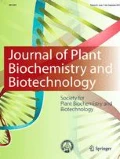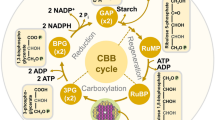Abstract
One century ago, the German chemist and botanist Wilhelm Pfeffer (1845–1920) died, shortly after finishing his last lecture at the University of Leipzig. Pfeffer was, together with Julius Sachs (1832–1897), the founder of modern plant physiology. In contrast to Sachs, Pfeffer’s work was exclusively based on the principles of physics and chemistry, so that with his publications, notably the ca. 1.600 pages-long Handbuch der Pflanzenphysiologie (2. ed., Vol. I/II; 1897/1904), experimental plant research was founded. Here we summarize Pfeffer’s life and work with special emphasis on his experiments on osmosis, plant growth in light vs. darkness, gravitropism, cell physiology, photosynthesis and leaf movements. We document that Pfeffer was the first to construct/establish constant temperature rooms (growth chambers) for seed plants. Moreover, he pioneered in outlining the carbon-cycle in the biosphere, and described the effect of carbon dioxide (CO2)-enhancement on assimilation and plant productivity. Wilhelm Pfeffer pointed out that, at ca. 0.03 vol% CO2 (in 1900), photosynthesis is sub-optimal. Accordingly, due to human activities, anthropogenic CO2 released into the atmosphere promotes plant growth and crop yield. We have reproduced Pfeffer’s classical experiments on the role of CO2 with respect to plant development, and document that exhaled air of a human (ca. 4 vol% CO2) strongly promotes growth. We conclude that Pfeffer not only acted as a key figure in the establishment of experimental plant physiology. He was also the discoverer of the phenomenon of CO2-mediated global greening and promotion of crop productivity, today known as the “CO2-fertilization-effect”. These topics are discussed with reference to climate change and the most recent findings in this area of applied plant research.

taken from the private collection of U. Kutschera)

(adapted from Pfeffer, W.: Pflanzenphysiologie, Leipzig 1897/1904)

adapted from Pfeffer, W.: Pflanzenphysiologie, Leipzig 1897/1904)

adapted from Pfeffer, W.: Pflanzenphysiologie, Leipzig 1897/1904)

adapted from Pfeffer, W.: Pflanzenphysiologie, Leipzig 1897/1904)

adapted from Pfeffer, W.: Pflanzenphysiologie, Leipzig 1897/1904). These classical drawings are supplemented by a transmission electron micrograph of a chloroplast in the primary leaf of a light-grown rye seedling (c) (original micrograph of U. K.)

adapted from Pfeffer, W.: Pflanzenphysiologie, Leipzig 1897/1904)



(adapted from Tabor, A.: nasa.gov, Febr. 11, 2019)

(adapted from Schönwiese 2019)

(adapted from Pfeffer 1915)
Similar content being viewed by others
Abbreviations
- CO2 :
-
Carbon dioxide
- O2 :
-
Oxygen
- H2O:
-
Water
- Face:
-
Free-air CO2 enrichment
- C3:
-
Basic photosynthetic metabolism
- NASA:
-
National Aeronautics and Space Administration
References
Ainsworth EA, Rogers A (2007) The response of photosynthesis and stomatal conductance to rising [CO2]: mechanisms and environmental interactions. Plant Cell Environ 30:258–270
Bastin J-F, Finegold Y, Garcia C et al (2019a) The global tree restoration potential. Science 365:76–79
Bastin J-F, Finegold Y, Garcia C et al (2019b) Response to Comments on “The global tree restoration potential.” Science aay8108:1–6
Bierwirth PN (2020) Carbon dioxide toxicity and climate change: a major unapprehended risk for human health. Res Gate. https://doi.org/10.13140/RG.2.2.16787.48168,1-22
Bünning E (1975) Wilhelm Pfeffer. Apotheker, Chemiker, Botaniker, Physiologe 1845–1920. Wissenschaftliche Verlagsgesellschaft, Stuttgart
Bünning E (1977) Fifty years of research in the wake of Wilhelm Pfeffer. Annu Rev Plant Physiol 28:1–22
Campbell JE, Berry JA, Seibt U et al (2017) Large historical growth in global terrestrial gross primary production. Nature 544:84–87
Cernusak LA, Haverd V, Brendel O, Le Thiec D, Guehl J-M, Cuntz M (2019) Robust response of terrestrial plant to rising CO2. Trends Plant Sci 24:578–586
Chandrashekaran MK (1998) Biological rhythms research: a personal account. J Biosci 23:545–555
Chen C, Park T, Wang X et al (2019) China and India lead in greening of the world through land-use management. Nature Sustain 2:122–129
Clausen J, Beckmann K, Junge W, Messinger J (2005) Evidence that bicarbonate is not the substrate in photosynthetic oxygen evolution. Plant Physiol 139:1444–1450
Davis WJ (2017) The relationship between atmospheric carbon dioxide concentration and global temperature for the last 425 million years. Climate 5(76):1–35
Dieleman WIJ, Vicca S, Dijkstra FA et al (2012) Simple additive effects are rare: a quantitative review of plant biomass and soil process responses to combined manipulations of CO2 and temperature. Glob Change Biol 18:2681–2693
Downs RJ, Hellmers H (1975) Environment and the experimental control of plant growth. Academic Press, London
Fitting H (1920) Wilhelm Pfeffer. Ber Dt Bot Ges 38:1030–1063
Goedecke C (2020) 100th anniversary: death of Wilhelm Pfeffer. Chem Views
Idso SB (1991) The aerial fertilization effect of CO2 and its implications for global carbon cycling and maximum greenhouse warming. Bull Am Meterol Soc 72:962–965
Jacobson TA, Kler JS, Hernke MT, Braun RK, Meyer KC, Funk WE (2019) Direct human health risks of increased atmospheric carbon dioxide. Nat Sustain 2:691–701
Junge W (2019) Oxygenic photosynthesis: history, status and perspecitve. Q Rev Biophys 52/e1:1–16
Keenan TF, Prentice IC, Canadell JG, Williams CA, Wang H, Raupach M, Collatz J (2016) Recent pause in the growth rate of atmospheric CO2 due to enhanced terrestrial carbon uptake. Nat Commun 7(13428):1–9
Kellogg WW (1987) Mankind’s impact on climate: the evolution of an awareness. Clim Change 10:113–136
Khanna R, Kutschera U (2020a) Arabidopsis: two-hundredths anniversary of its name and the possibility of a hidden universal regulatory signal. J Plant Biochem Biotechnol 29:575–579
Khanna R, Kutschera U (2020b) Thought experiment: a hidden signal and an etioreceptor. J Plant Biochem Biotechnol 29:832–837
Koroidov S, Shevela D, Shutova T, Samuelsson G, Messinger J (2014) Mobile hydrogen carbonate acts as proton acceptor in photosynthetic water oxidation. Proc Natl Acad Sci USA 111:6299–6304
Kumar V (ed) (2017) Biological timekeeping: clocks, rhythms and behaviour. Springer, New Dehli
Kutschera U (1998) Grundpraktikum zur Pflanzenphysiologie. Quelle & Meyer Verlag, Wiesbaden
Kutschera U (2015a) a) Comment: 150 years of an integrative plant physiology. Nat Plants 1(15131):1–3
Kutschera U (2015 b) Basic versus applied research: Julius Sachs (1832–1897) and the experimental physiology of plants. Plant Signal Behav 10/9, e1062958:1–9
Kutschera U (2019) Physiologie der Pflanzen. Sensible Gewächse in Aktion. LIT-Verlag, Berlin
Kutschera U, Baluska F (2015) Editorial: Julius Sachs (1832–1897) and the unity of life. Plant Signal Behav 10/9, e1079679:1–2
Kutschera U, Briggs WR (2009) From Charles Darwin’s botanical country-house studies to modern plant biology. Plant Biol 11:785–795
Kutschera U, Briggs WR (2012) Root phototropism: From dogma to the mechanism of blue light perception. Planta 235:443–452
Kutschera U, Briggs WR (2013) Seedling development in buckwheat and the discovery of the photomorphogenic shade-avoidance response. Plant Biol 15:931–940
Kutschera U, Briggs WR (2016) Phototropic solar tracking in sunflower plants: an integrative perspective. Ann Bot 117:1–8
Kutschera U, Farmer S (2020) Ernst Haeckel, ancient forests, and the Anthropocene. Plant Signal Behav. https://doi.org/10.1080/15592324.2020.1719313:1-5
Kutschera U, Khanna R (2016) Plant gnotobiology: Epiphytic microbes and sustainable agriculture. Plant Signal Behav 11(12):e1256529:1–4
Kutschera U, Khanna R (2020) Auxin action in maize coleoptiles: challenges and open questions. Plant Signal Behav 15(6):e1762327:1–6
Kutschera U, Niklas KJ (2006) Photosynthesis research on yellowtops: macroevolution in progress. Theory Biosci 125:81–92
Kutschera U, Niklas KJ (2018) a) Julius Sachs 1868: The father of plant physiology. Am J Bot 105:1–11
Kutschera U, Niklas KJ (2018) Julius von Sachs‘ forgotten 1897-Article: sexuality and gender in plants vs. humans. Plant Signal Behav 13(7):e1489671:1–7
Kutschera U, Pieruschka R, Berry JA (2010) Leaf development, gas exchange characteristics and photorespiratory activity in maize seedlings. Photosynthetica 48:617–622
Kutschera U, Pieruschka R, Farmer S, Berry JA (2020) The Warburg-Effects: basic metabolic processes with reference to cancer development and global photosynthesis. Plant Signal Behav 15(7):e1776477:1–10
Lindzen R (2018) Global warming for the two cultures. Annual GWPF Lecture, Oct. 2018. The Global Warming Policy Foundation, London
Morton DA (1981) History of Botanical Sciences. Academic Press, London
Nagendrappe, G. (2007) Jacobus Henricus van’t Hoff. A short biographical sketch. Resonance, May 2007, 21–30.
Nawaz R, Sharif A, Rehman W (2019) Earth thermal emissions and global warming. J Sci Res Rep 23:1–10
Norby R, Wullschleger SD, Gunderson CA, Nietch CT (1995) Increased growth efficiency of Quercus alba trees in a CO2-enriched atmosphere. New Phytol 131:91–97
Parker S (2014) Wilhelm Friedrich Phillip Pfeffer (1845–1920). Embryo Project Encycl 11(30):1–5
Pfeffer W (1865) Ueber die Derivate des Glyzerins und dessen Überführung in Allylen. Inaugural-Dissertation, Universität Göttingen
Pfeffer W (1867) Aus der Mooswelt der Alpen. Jb d Schweiz Alpenclubs 4:454–477
Pfeffer W (1871) Die Wirkung farbigen Lichtes auf die Zersetzung der Kohlensäure in Pflanzen. Arb d Bot Inst Würzburg 1:1–76 (Habil-Schrift, Marburg)
Pfeffer W (1873) Physiologische Untersuchungen. Wilhelm Engelmann, Leipzig
Pfeffer W (1877) Osmotische Untersuchungen. Studien zur Zellmechanik, Wilhelm Engelmann, Leipzig
Pfeffer W (1894) Geotropic sensitiveness of the root tip. Ann Bot 8:317–320
Pfeffer W (1895) Ein Zimmer mit konstanten Temperaturen. Ber Dtsch Bot Ges 13:49–54
Pfeffer W (1897/1904) Pflanzenphysiologie. Ein Handbuch der Lehre vom Stoffwechsel und Kraftwechsel in der Pflanze. Bd. I und II. 2. Auflage. Verlag Wilhelm Engelmann, Leipzig
Pfeffer W (1898) The nature and significance of functional metabolism in the plant. Proc R Soc Lond 68:93–101
Pfeffer W (1900) Die Anwendung des Projektionsapparates zur Demonstration von Lebensvorgängen. Jahrb f Wiss Bot 35:711–745
Pfeffer W (1907) Untersuchungen über die Entstehung der Schlafbewegungen der Blattorgane. Abhandl d math-phys Kl d kgl sächs Gesellsch d Wiss Leipzig 30:259–473
Pfeffer W (1911) Der Einfluß von mechanischer Hemmung und von Belastung auf die Schlafbewegung. Abhandl d math-phys Kl d kgl sächs Gesellsch d Wiss Leipzig 32:163–295
Pfeffer W (1915) Beiträge zur Kenntnis der Entstehung der Schlafbewegungen. Abhandl d math-phys Kl d kgl sächs Gesellsch d Wiss Leipzig 34:1–154
Piao S, Wang X, Park T et al (2020) Characteristics, drivers and feedbacks of global greening. Nat Rev Earth Environ 1:1–14
Rhodes RH, Bertler NAN, Baker JA, Stehen-Larsen HC, Sneed SB, Morgenstern U, Johnsen SJ (2012) Little Ice Age climate an oceanic conditions of the Ross Sea, Antarctica from a coastal ice core record. Clim Past 8:1223–1238
Sachs J (1865) Handbuch der Experimental-Physiologie der Pflanzen. Verlag Wilhelm Engelmann, Leipzig
Sachs J (1868) Lehrbuch der Botanik. Verlag Wilhelm Engelmann, Leipzig (4. Auflage 1874)
Sachs J (1887) Vorlesungen über Pflanzen-Physiologie, 2nd edn. Verlag Wilhelm Engelmann, Leipzig
Schimel D, Stephens BB, Fisher JB (2015) Effect of increasing CO2 on the terrestrial carbon cycle. Proc Natl Acad Sci USA 112:436–441
Schönwiese C (2019) Klimawandel kompakt. Ein globales Problem wissenschaftlich erklärt. Gebrüder Bornträger Verlagsbuchhaltung, Stuttgart
Wang S, Zhang Y, Ju W et al (2020) Recent global decline of CO2 fertilization effects on vegetation photosynthesis. Science 370:1295–1300
Warburg O (1964) Prefatory Chapter. Annu Rev Biochem 33:1–15
Went FW (1957) The experimental control of plant growth. Roland Press, New York
Yadav SK, Kauldhar BS, Sandhu PP, Thakur K, Sucheta STR (2020) Retrospect and prospects of secondary agriculture and bioprocessing. J Plant Biochem Biotechnol 29:1–14
Zhu Z, Piao S, Myneni RB et al (2016) Greening of the Earth and its drivers. Nat Clim Change 6:791–796
Acknowledgements
The first outline of this manuscript was discussed by the authors with our former mentor and colleague Prof. Winslow R. Briggs (1928–2019). We have written this version of the text with Winslow’s ideas and inspiration in mind, and dedicate this article to his memory. The cooperation of U. K. (University of Kassel, Germany, until March 2021) and R. K. is supported by the Alexander von Humboldt-Foundation (Bonn, Germany; AvH Fellowship, Stanford 2014 to U. K.).
Funding
See Acknowledgements.
Compiance with ethical standards
Author information
Authors and Affiliations
Corresponding author
Ethics declarations
Conflict of interest
The authors declare that they have no conflict of interest.
Additional information
Publisher's Note
Springer Nature remains neutral with regard to jurisdictional claims in published maps and institutional affiliations.
Rights and permissions
About this article
Cite this article
Kutschera, U., Khanna, R. Experimental plant research and the discovery of carbon dioxide-mediated global greening: a tribute to Wilhelm Pfeffer (1845–1920). J. Plant Biochem. Biotechnol. 30, 407–420 (2021). https://doi.org/10.1007/s13562-020-00644-y
Received:
Accepted:
Published:
Issue Date:
DOI: https://doi.org/10.1007/s13562-020-00644-y




